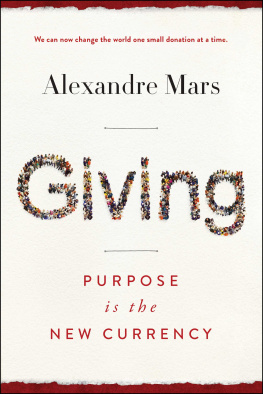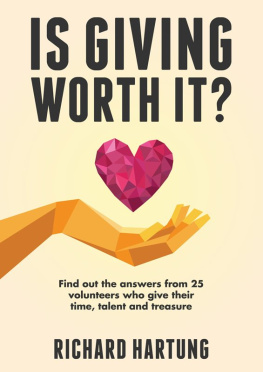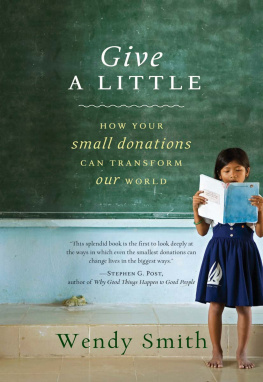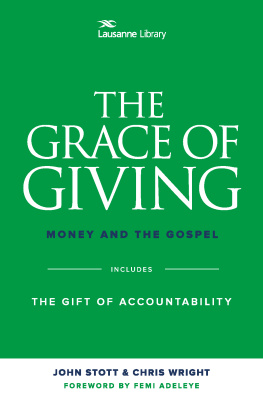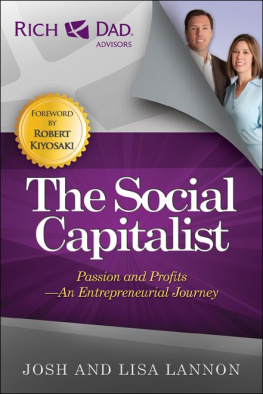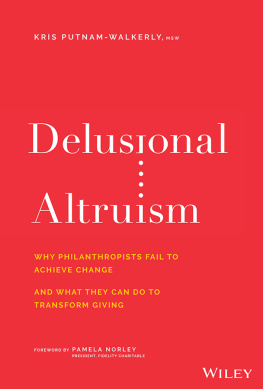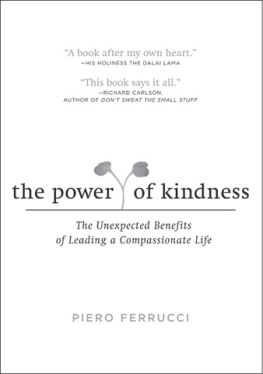The opposite of poverty is not wealth.
The opposite of poverty is sharing.
For the past few years, Ive been traveling the world, asking anyone and everyone two questions. The scene often plays out like this:
Ill say, Raise your hand if over the past year, you have given to charity. The hands go up.
I continue, Now keep your hand in the air if you think you have given enough.
An awkward silence fills the air. Almost everyone lowers their hand. People look right and left, perhaps to reassure themselves that all their neighbors have also lowered their arms. Perhaps because they somehow feel something is off. This happened everywhere I went. From recent graduates in Bogot to execs in London, everyone felt they had more to give.
Before these two questions took over my life, I had worked tirelessly for twenty-five years to launch and develop start-ups. I wasnt always successfulIve been laughed out of more than one boardroom and have struggled to pay my bills. But sometimes I got lucky, and experience eventually taught me the valuable lesson of how to detect trends before they became mainstream. When early web browsers got more user-friendly, I bet my life savings on creating a web design agency. When 3G phones were launching in South Korea, I figured brands would start marketing on mobile phones and formed a mobile ad agency. Later, roughly around the time Myspace was overtaken by Facebook, I turned my eyes to commercial social media management. Yet despite my financial success, I rarely left work feeling fulfilled. My parentsespecially my motheralways taught the importance of looking out for others and giving back. In my adult life, my wifewhose volunteer work has always inspired meand I made sure to pass on these values to our children. But my goal was very clear when I started working: I had to make money quickly to get my freedom and then be able to devote the rest of my life to helping others. I soon realized this first objective then I was able to start a new chapter in my life.
In 2013, I decided to change everything and embark on a journey to learn about the worlds issues from the people working on the ground. Eventually, I found that our best strategy was to learn how to share.
It took me awhile to find the reason for the disconnect between how much we want to give and how much we actually give. I am an entrepreneur, and if five start-ups and twenty-five years have taught me one lesson, it is to look at a situation in terms of where people areour point Aand where people want to beour point B. When I traveled around the world meeting shareholders, specialists, foundations, officials, social entrepreneurs and donors, I asked them what they needed, what obstacles they faced. I did this because I wanted to figure out their current and pressing reality: what was their point A, and what was keeping them from their point B? I learned that non-governmental organizations (NGOs) didnt just need funding, but unrestricted grants as well. I learned that most people want to donate, but between family and work they never find time to research charities. Observing the obstacles that prevented donors from giving more, I narrowed the problem down to three causes: lack of trust, lack of time, and lack of knowledge.
In a world where management scandals and corruption regularly undermine our trust, people are skeptical of financial governance. During my research travels, people often brought up scandals, from United Ways CEO siphoning donations to pay for his girlfriends vacations back in the early 90s to the American Breast Cancer Foundations president paying her sons telemarketing company millions to generate donations. Nonprofits are held to higher standards because of their mission-driven goals. Any one scandal sets everyone back. Additionally, the difficulty of demonstrating their impact and increasing their reach combined with their lack of transparency and accountability makes it difficult for nonprofits to restore donor confidence. As a result, people dont trust the known social organizations they could fund, and they lack the time and resources necessary to determine which ones deserve their support.
There is an added problem when considering the elite connotations of philanthropy: in a culture where people are constantly asked to donate to churches, schools, hospitals, and disaster relief, giving more is not an easy motto to promote. On top of that, the US is experiencing a time of increased economic inequality. According to the Pew Research Center, wealth gaps between upper-income families and lower- and middle-income families are at the highest levels ever recorded. The rising wealth gap means that disposable income in the middle class is shrinking. The very word philanthropy becomes attached to a privileged few with millions to spare. But philanthropy shouldnt be aspirational: it should be accessible and personal. Enabling people to give more is not just about increasing the amount of donationsit is about changing the way we look at giving and the way we practice it.
Not everything I learned was flavored by doom and gloomI was shocked by the number of young people passionately and selflessly giving their time and money for the causes they cared about. I saw kids making signs and marching for womens rights and teenagers asking their friends to donate to charities instead of sending birthday presents. There is a growing desire to share, a positive drive to reach out. In fact, we are experiencing an era of unprecedented giving, with total American charitable giving exceeding $400 billion for the first time in recorded history in 2017. But this isnt the time to pat ourselves on the back for a job well donethere is still room for growth. Now is the time to take giving a step further.
After three years of research, I founded a nonprofit organization called Epic to address these problems. Revolutionizing the way we give comes down to two pivotal changes: giving better, and giving more.
Better is a relative term: I use it to imply that the way we give today is inefficient. Too few nonprofits clearly state what they aim to achieve, fewer still sufficiently measure their progress, and even fewer accurately and convincingly demonstrate their impact. Epics job is to find the nonprofits that do all these things.
In the interest of selectivity, we built a powerful due-diligence system similar to the venture capital process of shortlisting prospective investments. We visited hundreds of organizations to see the reality of their struggles on the ground and to encounter unsung heroes.
Giving better also means giving that does not stop when you mail a check or click SEND . We needed to change the way donors experience their impact. This led us to explore how to measure impact, how to report on it, and how to relay that information back to the donor. From virtual reality to news apps, field trips, and multidimensional reporting, we have worked to bridge the gap between donors and beneficiaries.
The search for new avenues of philanthropy brought us to explore workplace giving through painless payroll deductionslike a 401(k) for donating to nonprofits that employers can match. It brought me to examine the possibilities at cashiers and checkout counters where a few cents every now and thenalways optional, but always an optioncould create a tangible social impact when placed in the right hands. We need to make it possible for every sectorfrom finance to retailto embrace giving through approaches that fit the way they make money. By bringing together pledges and initiatives tailored for them, we can convince them to join us in this new giving journey.
And it works. Or more accurately, it is beginning to work. In companies that promote payroll giving, employees sign up in great numbers. At Dior, about a quarter of employees now give every month, and the company aims to reach 50 percent by the end of the year. While rolling out these solutions at LOral and Coca-Cola, weve seen the same mind-set developing: simple, painless solutions with a tangible impact on the lives of others will make people more inclined to give.

